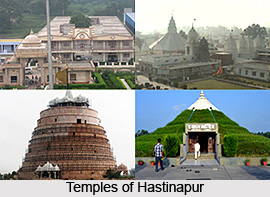 Hastinapur was the capital of the Kuru dynasty of Kings. The entire epic Mahabharata have taken place in this city of Hastinapura. The first reference to Hastinapur in Hindu mythology comes as the capital of Emperor Bharata. The entire Mahabharata revolves around the family rivalry of two sets of cousins the Pandavas, or the five sons of Pandu (Yudhisthira, Bhima, Arjuna, Nakula, and Sahadeva), and the Kauravas (descendants of Kuru), the one hundred sons of the blind Dhrtarastra, the eldest of whom was Duryodhana. Both the Kauravas and the Pandavas claimed the throne of Kuru land with its capital at Hastinapur about fifty-five miles (ninety kilometres) northeast of modern Delhi.
Hastinapur was the capital of the Kuru dynasty of Kings. The entire epic Mahabharata have taken place in this city of Hastinapura. The first reference to Hastinapur in Hindu mythology comes as the capital of Emperor Bharata. The entire Mahabharata revolves around the family rivalry of two sets of cousins the Pandavas, or the five sons of Pandu (Yudhisthira, Bhima, Arjuna, Nakula, and Sahadeva), and the Kauravas (descendants of Kuru), the one hundred sons of the blind Dhrtarastra, the eldest of whom was Duryodhana. Both the Kauravas and the Pandavas claimed the throne of Kuru land with its capital at Hastinapur about fifty-five miles (ninety kilometres) northeast of modern Delhi.
The chronicle of Hastinapur unveils the saga of the tears, agony, happiness and verve of the rulers who one after the other ruled Hastinapur.
Bharadwaj was appointed as the king by Bharat and then came King Hasti who established Hastinapur. After Hasti, Ajmeedh who was the son of Hasti ruled Hastinapur. The rich history of Hastinapur unfolds the fact that after Hasti, Kuru came into power and ruled Hastinapur. He died leaving his son Jahnu who later succeeded the throne. After Jahnu, Shantanu reigned. A new ruler named as Chitrangada afterwards ruled Hastinapur for quite sometime and was later replaced by his younger brother Vichitravirya. It is after Vichitravirya, Hastinapur witnessed a change and Pandu, the son of Vichitravirya became the new king. Pandu died at a young age and again Hastinapur found a new ruler - Dhritarashtra. After the demise of Dhritarashtra, his son Yudhisthira ruled Hastinapur. After Yudhisthira his brother`s son Parikshit reigned. Later his son Janmejaya ruled Hastinapur for a short span. Chandra Vansh dynasty came to an end with the demise of the last king Chemak.



















